Influence of Deposition Parameters on Structural and Electrochemical Properties of Ti/Ti2N Films Deposited by RF-Magnetron Sputtering
Abstract
1. Introduction
2. Materials and Methods
2.1. Deposition Conditions
2.2. Characterization
3. Results and Discussion
3.1. Structure Studies by XRD
3.2. Microstructure
3.2.1. Thickness and Morphology Analysis
3.3. Electrochemical Behavior of Ti2N Films
3.3.1. Potential Circuit Open Evaluation
3.3.2. Potentiodynamic Polarization Curves Evaluation
3.3.3. Bode Diagram Evaluation
4. Conclusions
Author Contributions
Funding
Institutional Review Board Statement
Informed Consent Statement
Data Availability Statement
Acknowledgments
Conflicts of Interest
References
- Atkinson, H.V. Structural and functional materials. In Materials Science and Engineering Vol. II Encyclopedia of Life Support Systems (EOLSS); University of Sheffield: Sheffield, UK, 2002; Available online: www.eolss.net/sample-chapters/c05/e6-36-02-00.pdf (accessed on 28 September 2021).
- Hosseini, A.; Kishawy, H.A. Cutting tool materials and tool wear. In Machining of Titanium Alloys. Materials Forming, Machining and Tribology; Davim, J.P., Ed.; Springer: Berlin/Heidelberg, Germany, 2014; pp. 31–56. ISBN 978-3-662-43901-2. [Google Scholar] [CrossRef]
- Budinski, K.G. Overview of Surface Engineering and Wear. In Effect of Surface Coatings and Treatments on Wear; Bahadur, S., Ed.; ASTM International: West Conshohocken, PA, USA, 1996; pp. 4–21. [Google Scholar] [CrossRef]
- Broqvist, N.; Hogmark, S.; Medvedevaa, A.; Gunnarsson, S. On wear resistance of tool steel. J. Manuf. Process. 2012, 14, 195–198. [Google Scholar] [CrossRef]
- Gorozyca, F.E. Application of Metal Cutting Theory; Editor Industrial Press Inc.: New York, NY, USA, 1987; p. 98. ISBN 0831111763/9780831111762. [Google Scholar]
- Bayer, A.M.; Becherer, B.A. High Speed Tool Steels. In ASM Handbook; Machining ASM Handbook Committee: Geauga, OH, USA, 1989; Volume 16, pp. 51–59. [Google Scholar] [CrossRef]
- Isakov, E. Cutting Data for Turning of Steel; Industrial Press Inc.: New York, NY, USA, 2007; p. 137. ISBN 9780831133146. [Google Scholar]
- Miltiadis, A.B. (Ed.) Manufacturing Processes and Materials: Exercises; Boboulus & Ventus Publishing ApS: Telluride, CO, USA, 2010; p. 21. ISBN 978-87-7681-695-7. Available online: http://www.iqytechnicalcollege.com/ME%20205%20Manufacturing%20Processes-and-Materials.pdf (accessed on 28 September 2021).
- Zetek, M.; Zetková, I. Increasing of the Cutting Tool Efficiency from Tool Steel by Using Fluidization Method. Procedia Eng. 2015, 100, 912–917. [Google Scholar] [CrossRef][Green Version]
- Balasubramanyam, N.; Prasanthi, S.G.; Yugandhar, M. Study of Coated TiN and TiC on Cutting Tools for the PVD and CVD Coated Tungsten Carbide by Sand Blasting Pretreatment of Nickel and Carbon. Int. J. Adv. Sci. Eng. Inf. Technol. 2015, 75, 51–58. [Google Scholar] [CrossRef]
- Morosanu, C.E. Thin Films by Chemical Vapor Deposition, 1st ed.; Elsevier: Amsterdam, The Netherlands, 1990; Volume 7, p. 19. [Google Scholar] [CrossRef]
- Luzhao, S.; Guowen, Y.; Libo, G.; Jieun, Y.; Manish, C.; Meysam, H.G.; Karen, K.G.; Yong, S.C.; Byung, H.H.; Zhongfan, L. Chemical vapour deposition. Nat. Rev. Methods Primers 2021, 5, 1. [Google Scholar] [CrossRef]
- Xilling, L.; Zhi, Y. Effects of sputtering conditions on the structure and magnetic properties of Ni–Fe films. Mater. Sci. Eng. B Solid-State Mater. Adv. Technol. 2004, 106, 41–45. [Google Scholar] [CrossRef]
- ASTM G1-03; Standard Practice for Preparing, Cleaning, and Evaluating Corrosion Test Specimen. ASM International: Geauga, OH, USA, 2011. Available online: https://www.asminternational.org/home/-/journal_content/56/33542825/358486/PUBLICATION-STANDARD-TEMPLATE (accessed on 21 September 2021).
- Pauzon, C.; Markströ, A.; Dubiez-Le Goff, S.; Hryha, E. Efect of the process atmosphere composition on alloy 718 produced by laser powder bed fusion. Metals 2021, 11, 1254. [Google Scholar] [CrossRef]
- Sjahrul, M.; Maming, H.M. Use of sodium silicate from rice husk ash basic materials for coating electolytes in the synthesis of magnetite nanoparticles. RJSITM 2013, 3, 46–56. [Google Scholar]
- Huang, C.H.; Yoshimura, M. Direct ceramic coating of calcium phosphate doped with strontium via reactive growing integration layer method on α-Ti alloy. Sci. Rep. 2020, 10, 10602. [Google Scholar] [CrossRef]
- Maleki, E.; Unal, O.; Kashyzadeh, K.R. Efficiency Analysis of Shot Peening Parameters on Variations of Hardness, Grain Size and Residual Stress via Taguchi Approach. Met. Mater. Int. 2019, 25, 1436–1447. [Google Scholar] [CrossRef]
- Schwandt, C.; Fray, D.J. The Electrochemical Reduction of Chromium Sesquioxide in Molten Calcium Chloride under Cathodic Potential Control. Z. Nat. A 2007, 62, 655–670. [Google Scholar] [CrossRef]
- Benning, L.G.; Waychunas, G.A. Nucleation, Growth, and Aggregation of Mineral Phases: Mechanisms and Kinetic Controls. In Kinetics of Water-Rock Interaction; Brantley, S., Kubicki, J., White, A., Eds.; Springer: New York, NY, USA, 2008; Chapter 7; pp. 1–77. [Google Scholar] [CrossRef]
- Mortalò, C.; Deambrosis, S.M.; Montagner, F.; Zin, V.; Fabrizio, M.; Pasquali, L.; Capelli, R.; Montecchi, M.; Miorin, E. Production Strategies of TiNx Coatings via Reactive High Power Impulse Magnetron Sputtering for Selective H2 Separation. Membranes 2021, 11, 360. [Google Scholar] [CrossRef] [PubMed]
- Wu, T.; Blawert, C.; Serdechova, M.; Karlova, P.; Dovzhenko, G.; Wieland, F.; Zheludkevich, M.L. Role of polymorph microstructure of Ti6Al4V alloy on PEO coating formation in phosphate electrolyte. Surf. Coat. Technol. 2021, 428, 127890. [Google Scholar] [CrossRef]
- Wang, P.; Li, Z.; Lin, G.; Zhou, S.; Yang, C.; Yong, Q. Influence of Vanadium on the Microstructure and Mechanical Properties of Medium-Carbon Steels for Wheels. Metals 2018, 8, 978. [Google Scholar] [CrossRef]
- Korusenko, P.M.; Nesov, S.N.; Povoroznyuk, S.N.; Orlov, P.V.; Korotaev, D.N.; Poleshchenko, K.N. Chemical Composition and Mechanical Properties of Coatings Based on TiN Formed Using a Condensation with Ion Bombardment. Prot. Met. Phys. Chem. Surf. 2020, 56, 539–548. [Google Scholar] [CrossRef]
- Sun, Y.; Bailey, R. Effect of applied cathodic potential on friction and wear behavior of CoCrMo alloy in NaCl solution. Lubricantes 2020, 8, 2–15. [Google Scholar] [CrossRef]
- Zaki, A. Principles of Corrosion Engineering and Corrosion Control. In Cathodic Protectionn; Butterworth-Heinemann: Oxford, UK, 2006; Chapter 5; pp. 271–351. ISBN 9780750659246. [Google Scholar] [CrossRef]
- Ren, Y.; Jian, C.; Yaqing, C.; Jianlin, C.; Wei, Q. Effects of Substrate Temperature on the Corrosion Behaviour of Nanochromium Coatings Deposited by Direct Current Magnetron Sputtering. J. Nanomater. 2016, 2016, 4894062. [Google Scholar] [CrossRef]
- García-Valenzuela, A.; Fakhfouri, A.; Oliva-Ramírez, M.; Rico-Gavira, V.; Rojas, T.C.; Alvarez, R.; Menzel, S.B.; Palmero, A.; Winkler, A.; González-Elipe, R.A. Patterning and control of the nanostructure in plasma thin films with acoustic waves: Mechanical vs. electrical polarization effects. Mater. Horiz. 2021, 8, 515–524. [Google Scholar] [CrossRef]
- Shu, R.; Paschalidou, E.-M.; Rao, S.G.; Boyd, B.B.R.; Moro, M.V.; Primetzhofer, D.; Greczynski, G.; Nyholm, L.; Febvrier, A.L.; Eklund, P. Effect of nitrogen content on microstructure and corrosion resistance of sputter-deposited multicomponent (TiNbZrTa)Nx films. Surf. Coat. Technol. 2020, 404, 126485. [Google Scholar] [CrossRef]
- Hashim, I.H.; Aadim, K.A.; Ali, M.R. Effect of gas flow rate on plasma temperature and electron density of atmospheric argon plasma jet. Iraqi J. Phys. 2017, 15, 1117–1124. [Google Scholar]
- Shri, D.N.A.; Tsuchiya, K.; Yamamoto, A. Corrosion behavior of HPT-deformed TiNi alloys in cell culture medium. In Proceedings of the 4th International Conference on the Advancement of Materials and Nanotechnology (ICAMN IV 2016) AIP, Langkawi, Malaysia, 9–11 November 2016; AIP Publishing: College Park, MD, USA, 2016. No. 1877. ISBN 978-0-7354-1557-7. [Google Scholar] [CrossRef]
- Domínguez-Crespo, M.A.; Torres-Huerta, A.M.; Rodríguez, E.; González-Hernández, A.; Brachetti-Sibaja, S.B.; Dorantes-Rosales, H.J.; López-Oyama, A.B. Effect of deposition parameters on structural, mechanical, and electrochemical properties in Ti/TiN thin films on AISI 316L substrates produced by r. f. magnetron sputtering. J. Alloys Compd. 2018, 746, 688–698. [Google Scholar] [CrossRef]
- Hong-Ying, C.; Fu-Hsing, L. Oxidation behavior of titanium nitride films. J. Vac. Sci. Technol. A 2005, 23, 1006–1009. [Google Scholar] [CrossRef]
- Khojier, K.; Savaloni, H.; Shokrai, E.; Dehghani, Z.; Dehnavi, N.Z. Influence of argon gas flow on mechanical and electrical properties of sputtered titanium nitride thin films. J. Theor. Appl. Phys. 2013, 7, 2–6. [Google Scholar] [CrossRef]
- Yinghe, M.; Kexin, Z.; Jianguo, Y.; Xiubo, T.; Chunzhi, G.; Wenjian, Z.; Yanming, H.; Zengliang, G.; Lianfeng, W.; Chu, P.K. Effects of the target-to-substrate distance on the microstructure and properties of TiN coatings fabricated by pulse-enhanced vacuum arc evaporation. J. Adhes. Sci. Technol. 2021, 35, 1125–1137. [Google Scholar] [CrossRef]
- Freixas, J.; Eustache, E.; Roussel, P.; Brillard, C.; Deresmes, D.; Nuns, N.; Rolland, N.; Brousse, T.; Lethiena, C. Sputtered titanium nitride: A bifunctional material for Li-Ion Microbatteries. J. Electrochem. Soc. 2015, 162, A493–A500. [Google Scholar] [CrossRef]
- Kim, H.T.; Park, J.Y.; Park, C. Effects of nitrogen flow rate on titanium films deposition by DC facing target sputtering method. Korean J. Chem. Eng. 2012, 29, 676–679. [Google Scholar] [CrossRef]
- Grayeli, A.R.; Korpi, P.; Balshabadi, M.M.; Larijani, M.; Habibi, A.; Hamidi, A.; Malek, M. Effect of Gas Ratio on Tribological and Corrosion Properties of Ion Beam Sputter Deposited TiN Coatings. Prog. Color Colorants Coat. 2018, 11, 129–135. [Google Scholar] [CrossRef]
- Choudhary, R.K.; Mishra, P.; Roychowdhury, S.; Kain, V. Effect of substrate temperature and nitrogen concentration during sputtering on corrosion behaviour of AlN coatings. Trans. IMF Int. J. Surf. Eng. Coat. 2016, 94, 250–253. [Google Scholar] [CrossRef]
- Menghani, J.; Pai, K.B.; Totlani, M.K. Corrosion and wear behaviour of ZrN thin films. Mater. Surf. Interfaces 2011, 5, 122–128. [Google Scholar] [CrossRef]
- Fattah-Alhosseini, A.; Shoja, S.T.; Zebardast, B.H.; Samim, P.M. An Electrochemical Impedance Spectroscopic Study of the Passive State on AISI 304 Stainless Steel. Int. J. Electrochem. 2011, 2011, 8–16. [Google Scholar] [CrossRef]
- Babaeia, K.; Fattah-Alhosseinia, A.; Elmkhaha, H.; Ghomi, H. Surface characterization and electrochemical properties of tantalum nitride (TaN) nanostructured coatings produced by reactive DC magnetron sputtering. Surf. Interfaces 2020, 21, 100685. [Google Scholar] [CrossRef]

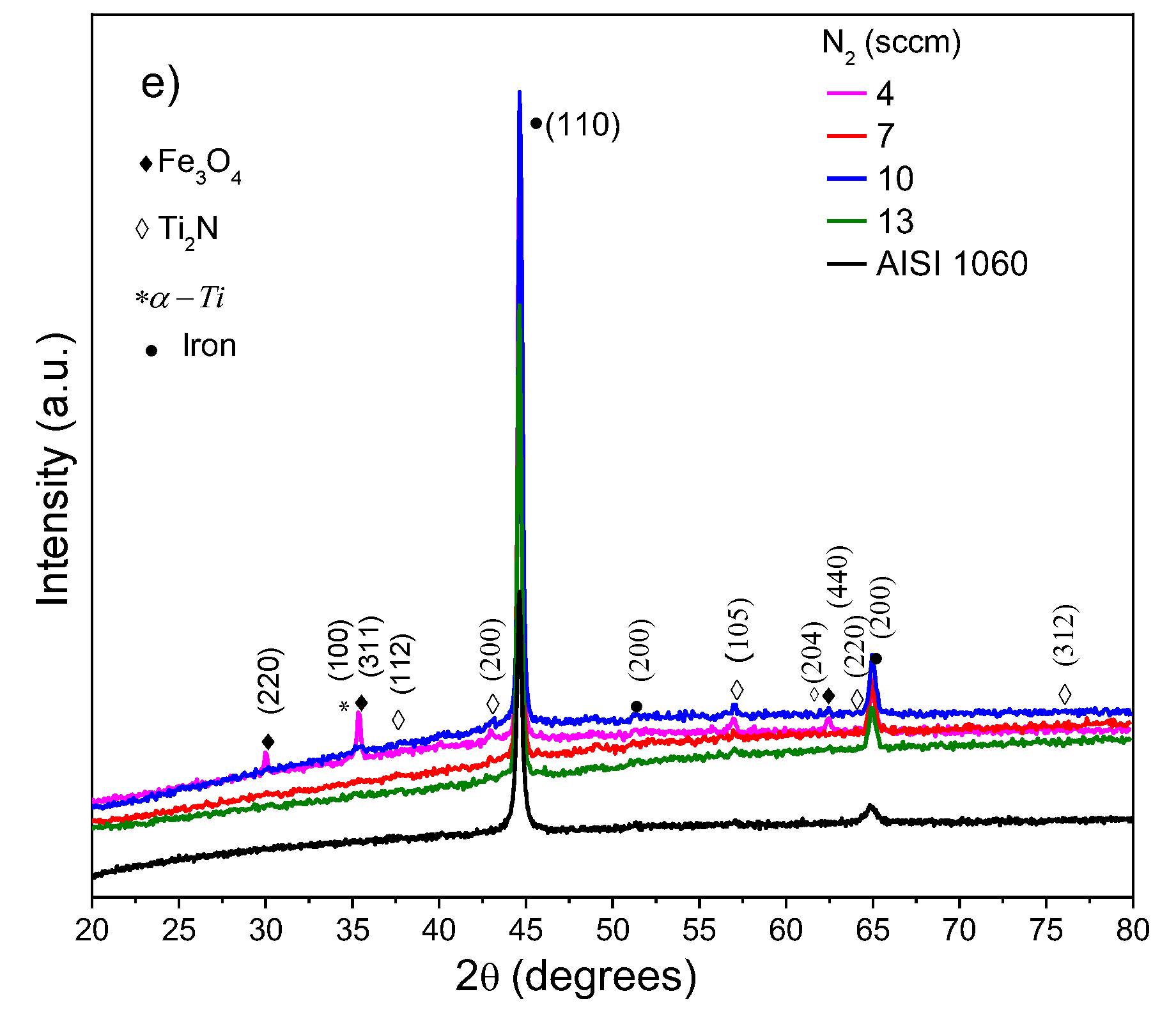
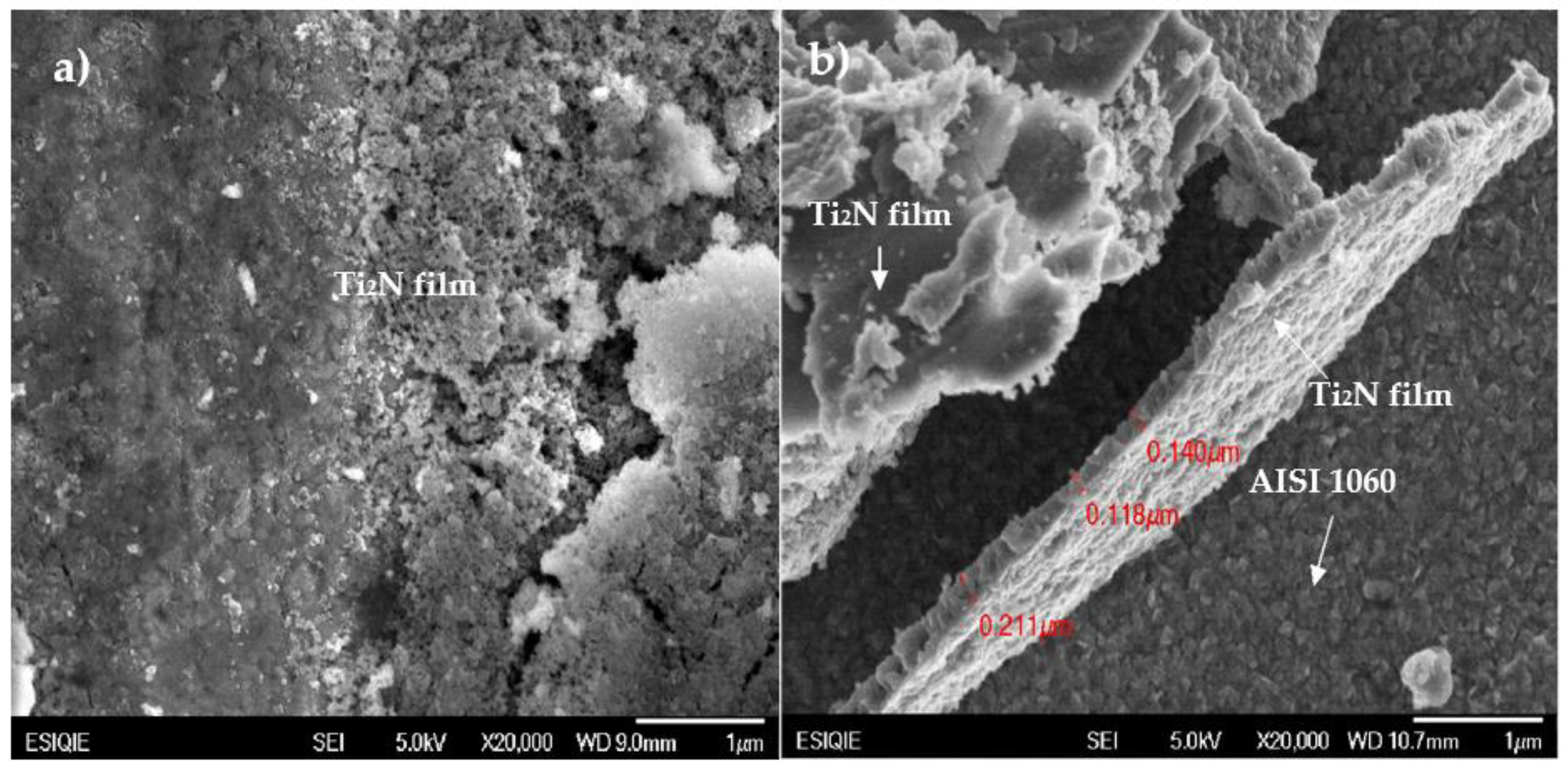
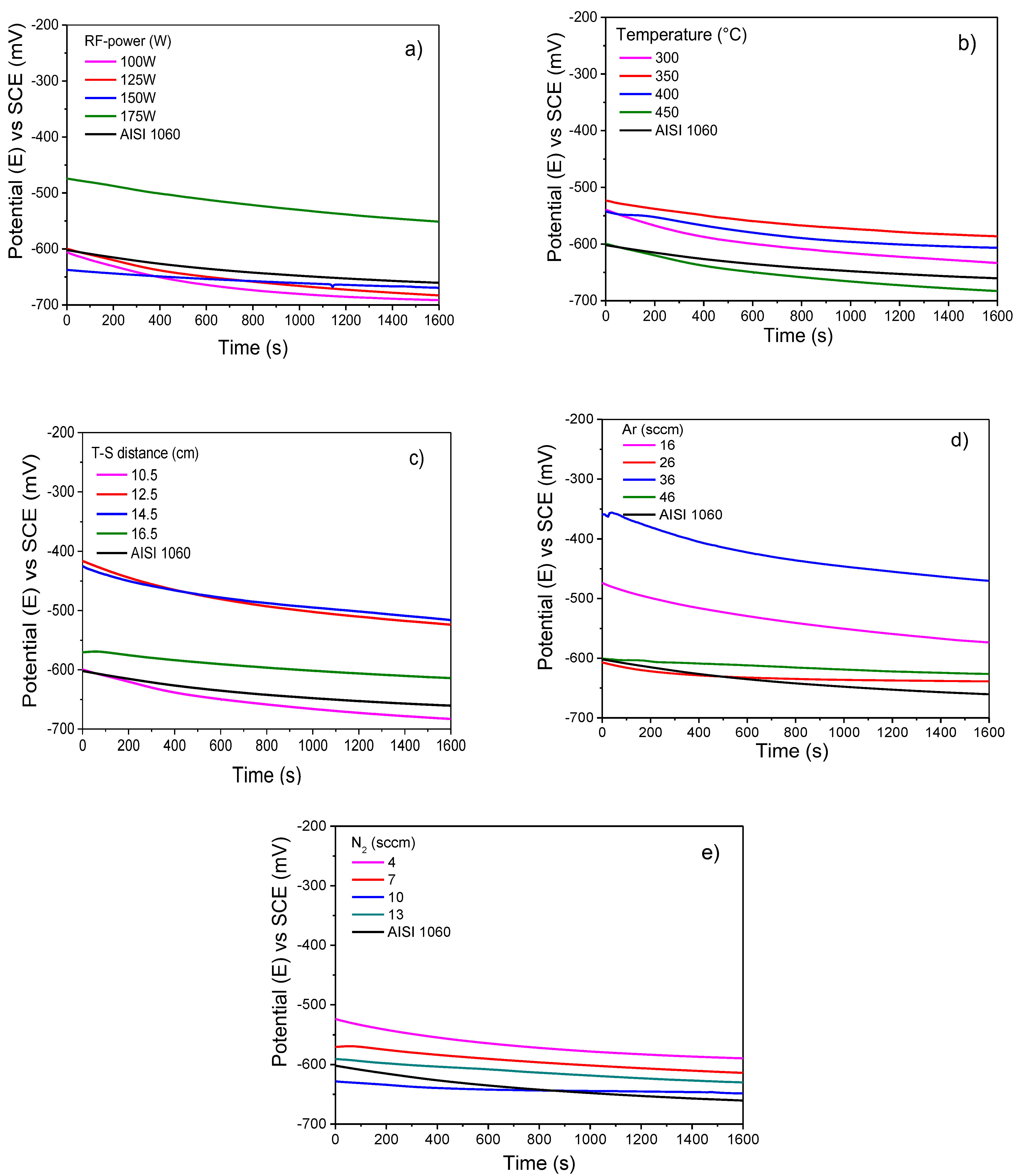
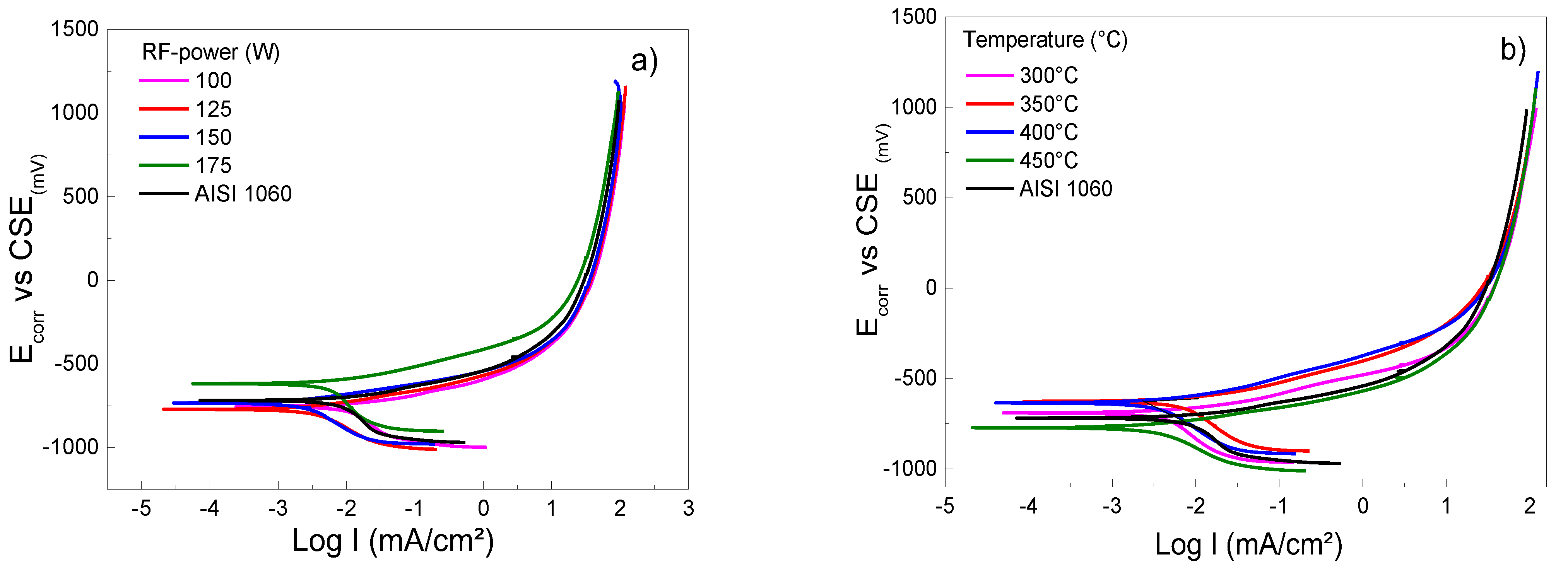

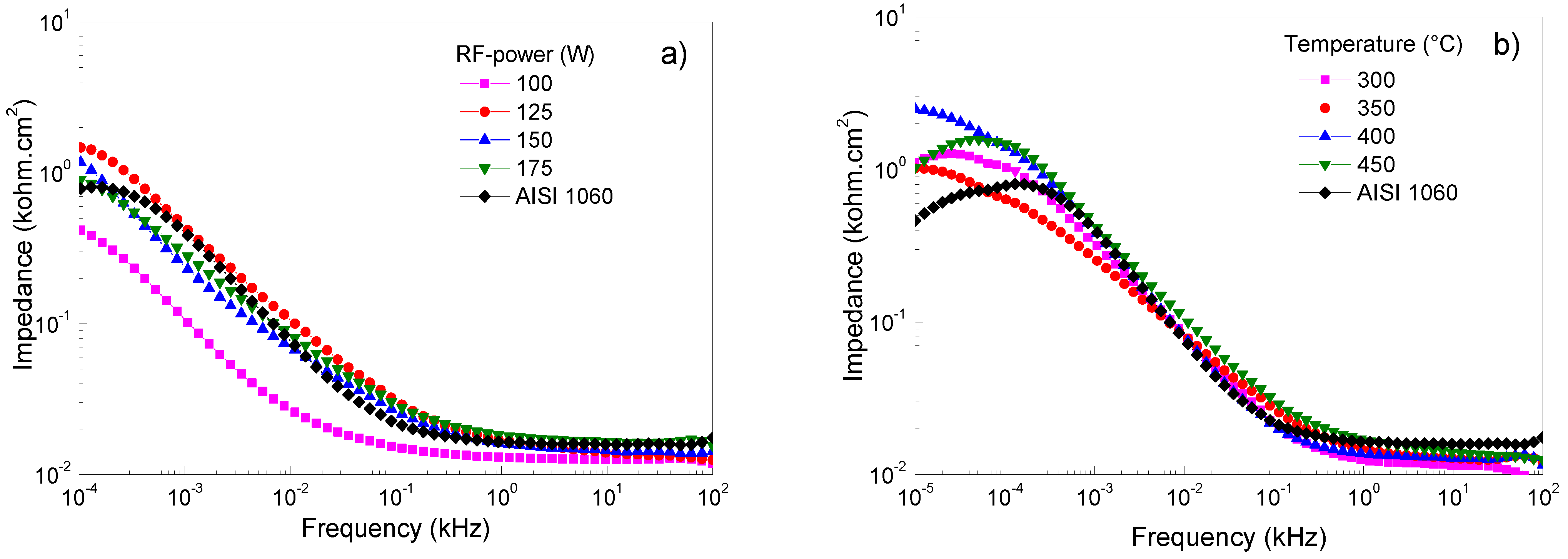
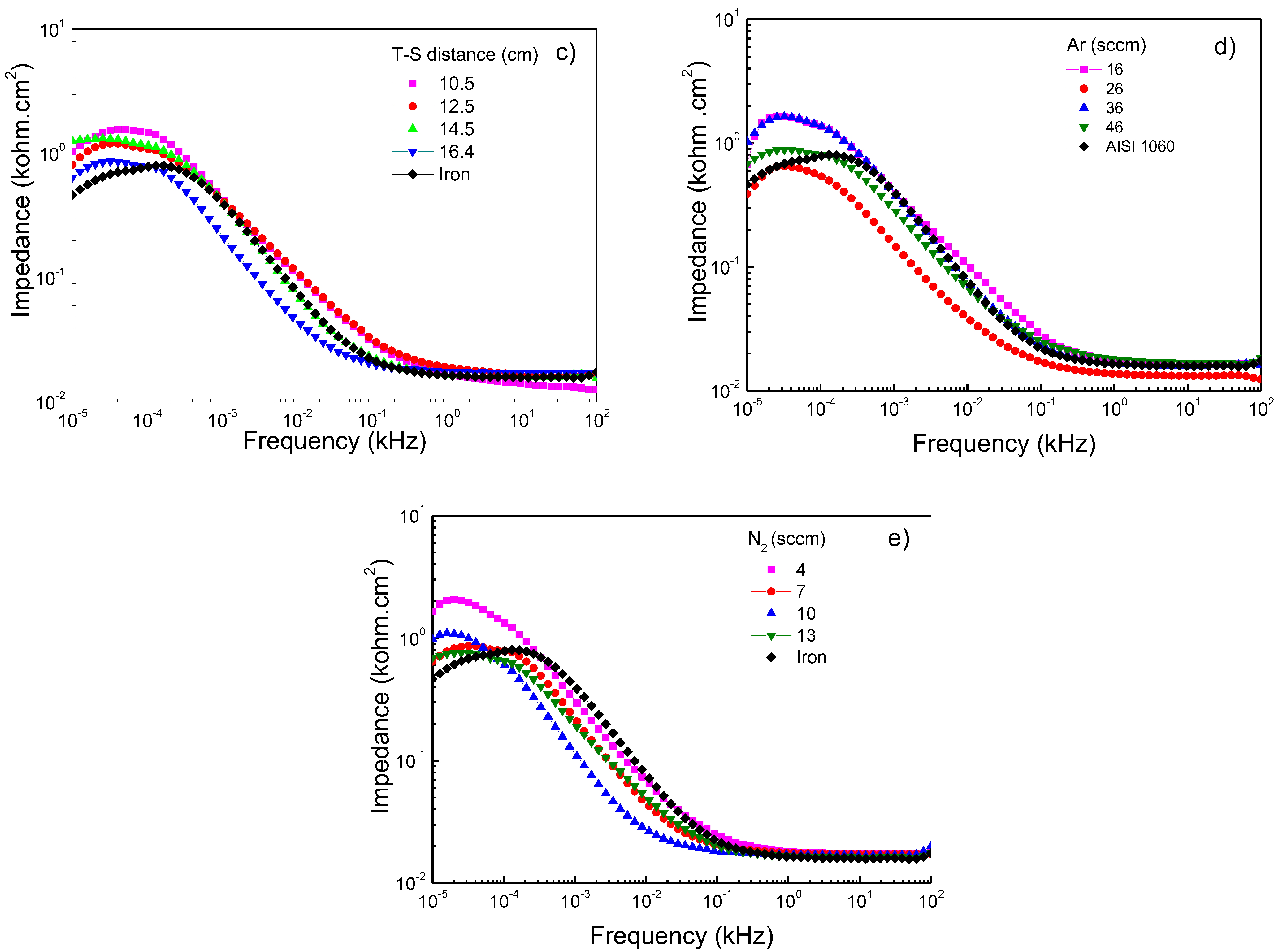
| Fixed Parameters | Varied Parameter | Fixed Parameters | Varied Parameter |
|---|---|---|---|
| Set 1 | Set 4 | ||
| Condition | RF-power (W) | Condition | Ar flux (sccm) |
| Tsubs = 300 °C | 100 | Tsubs = 450 °C | 16 |
| DT-S = 10.5 cm | 125 * | DT-S = 10.5 cm | 26 |
| Ar flux = 16 sccm | 150 | RF Power = 125 W | 36 |
| N2 flux = 7 sccm | 175 | N2 flux = 7 sccm | 46 * |
| Set 2 | Set 5 | ||
| Condition | Temperature (°C) | Condition | N2 flux (sccm) |
| RF Power = 125 W | 300 | Tsubs = 450 °C | 4 |
| DT-S = 10.5 cm | 350 | DT-S = 10.5 cm | 7 |
| Ar flux = 16 sccm | 400 | RF Power = 125 W | 10 |
| N2 flux = 7 sccm | 450 * | Ar flux = 46 sccm | 13 |
| Set 3 | |||
| Condition | Distance T-S (cm) | ||
| Tsubs = 450 °C | 10.5 | ||
| RF Power = 125 W | 12.5 | ||
| Ar flux = 16 sccm | 14.5 | ||
| N2 flux = 7 sccm | 16.5 * | ||
| Parameter | E Starting (mVvsSCE) | E End (mVvsSCE) | Absolute Difference (E) |
|---|---|---|---|
| RF-175 (W) | 477 | 550 | 73 |
| 350 (°C) | 521 | 581 | 60 |
| 12.5 (cm) | 415 | 525 | 110 |
| 36 (Ar sccm) | 358 | 470 | 112 |
| 4 (N2 sccm) | 523 | 588 | 65 |
| Parameter | Ecorr (mVvsSCE) | Icorr (mA/cm2) |
|---|---|---|
| RF-175 (W) | - 621 | - 2.26 |
| 400 (°C) * | - 634 | - 2.57 |
| 14.5 (cm) | - 569 | - 2.43 |
| 46 (Ar sccm) * | - 550 | - 2.45 |
| 4 (N2 sccm) * | - 605 | - 2.47 |
| Parameter | Rs | Rp |
|---|---|---|
| kΩ cm2 | kΩ cm2 | |
| RF-150 (W) | 0.013 | 1.481 |
| 400 (°C) | 0.012 | 2.662 |
| 14.5 (cm) | 0.015 | 1.237 |
| 46 (Ar sccm) | 0.016 | 1.013 |
| 4 (N2 sccm) | 0.019 | 1.612 |
Publisher’s Note: MDPI stays neutral with regard to jurisdictional claims in published maps and institutional affiliations. |
© 2022 by the authors. Licensee MDPI, Basel, Switzerland. This article is an open access article distributed under the terms and conditions of the Creative Commons Attribution (CC BY) license (https://creativecommons.org/licenses/by/4.0/).
Share and Cite
González-Hernández, A.; Aperador, W.; Flores, M.; Onofre-Bustamante, E.; Bermea, J.E.; Bautista-García, R.; Gamboa-Soto, F. Influence of Deposition Parameters on Structural and Electrochemical Properties of Ti/Ti2N Films Deposited by RF-Magnetron Sputtering. Metals 2022, 12, 1237. https://doi.org/10.3390/met12081237
González-Hernández A, Aperador W, Flores M, Onofre-Bustamante E, Bermea JE, Bautista-García R, Gamboa-Soto F. Influence of Deposition Parameters on Structural and Electrochemical Properties of Ti/Ti2N Films Deposited by RF-Magnetron Sputtering. Metals. 2022; 12(8):1237. https://doi.org/10.3390/met12081237
Chicago/Turabian StyleGonzález-Hernández, Andrés, William Aperador, Martín Flores, Edgar Onofre-Bustamante, Juan E. Bermea, Roberto Bautista-García, and Federico Gamboa-Soto. 2022. "Influence of Deposition Parameters on Structural and Electrochemical Properties of Ti/Ti2N Films Deposited by RF-Magnetron Sputtering" Metals 12, no. 8: 1237. https://doi.org/10.3390/met12081237
APA StyleGonzález-Hernández, A., Aperador, W., Flores, M., Onofre-Bustamante, E., Bermea, J. E., Bautista-García, R., & Gamboa-Soto, F. (2022). Influence of Deposition Parameters on Structural and Electrochemical Properties of Ti/Ti2N Films Deposited by RF-Magnetron Sputtering. Metals, 12(8), 1237. https://doi.org/10.3390/met12081237








